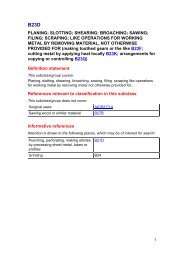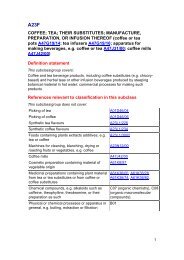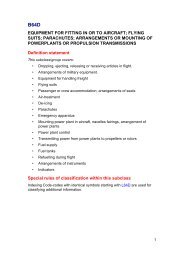A61K - Cooperative Patent Classification
A61K - Cooperative Patent Classification
A61K - Cooperative Patent Classification
Create successful ePaper yourself
Turn your PDF publications into a flip-book with our unique Google optimized e-Paper software.
CPC - <strong>A61K</strong> - 2013.07 - page 75<br />
NOTE<br />
-<br />
Porphyrins used as simple heterocyclic carriers containing a<br />
radioactive nucleus (e.g. 11C) or substituted with a radioactive nucleus<br />
(e.g. 18F), are classified in <strong>A61K</strong> 51/0451<br />
<strong>A61K</strong> 51/0487 . . . . { Metallocenes, i.e. complexes based on a radioactive metal complexed by<br />
two cyclopentadienyl anions }<br />
<strong>A61K</strong> 51/0489 . . . { Phosphates or phosphonates, e.g. bone-seeking phosphonates; (<br />
phospholipids: <strong>A61K</strong> 51/0408 ; nucleotides or nucleic acids: <strong>A61K</strong> 51/0491 ) }<br />
<strong>A61K</strong> 51/0491 . . . { Sugars, nucleosides, nucleotides, oligonucleotides, nucleic acids, e.g. DNA,<br />
RNA, nucleic acid aptamers }<br />
<strong>A61K</strong> 51/0493 . . . { Steroids, e.g. cholesterol, testosterone }<br />
<strong>A61K</strong> 51/0495 . . . { Pretargeting }<br />
NOTE<br />
-<br />
Pretargeting is the administration of an agent X bearing the radioisotope or<br />
radioactive nucleus and of an agent Y capable of binding X and a cell Y in<br />
several steps, e.g. the radiolabelled agent is a radiolabelled biotin and the<br />
agent Y is a (strept)avidin molecule targeting specific cells. <strong>Classification</strong><br />
is also made according to the nature of the carrier bearing/linked to the<br />
radioactive nucleus, e.g. an antibody<br />
<strong>A61K</strong> 51/0497 . . . { conjugates with a carrier being an organic compounds }<br />
NOTE<br />
-<br />
The compound which bears, complexes or chelates the radioactive<br />
nucleus, is covalently linked or complexed to the carrier being another<br />
(small) organic molecule, i.e. not oligomeric, polymeric, dendrimeric.<br />
<strong>Classification</strong> is also made according to the nature of this small organic<br />
molecule. In case of a conjugate comprising a complex-forming compound<br />
(chelating group) complexing a radioactive metal linked to the carrier<br />
(organic compound in <strong>A61K</strong> 49/04Z ), the nature of this complex-forming<br />
compound is not classified except if the complexing/chelating group is the<br />
subject of the invention and is uncommon, e.g. 111In-DTPA-glucose is<br />
classified in <strong>A61K</strong> 51/0497 (not in <strong>A61K</strong> 51/048 ) and in <strong>A61K</strong> 51/0491<br />
<strong>A61K</strong> 51/06 . . . Macromolecular compounds, { carriers being organic macromolecular<br />
compounds, i.e. organic oligomeric, polymeric, dendrimeric molecules (<br />
peptides, proteins, polyamino acids <strong>A61K</strong> 51/08 ; antibodies <strong>A61K</strong> 51/10 ) }<br />
<strong>A61K</strong> 51/065 . . . . { conjugates with carriers being macromolecules }<br />
NOTE<br />
-<br />
The compound which bears, complexes or chelates the radioactive<br />
nucleus, is covalently linked or complexed to the carrier being a<br />
macromolecule (not being a peptide, polyamino acid, protein,<br />
antibody). In case of a conjugate comprising a complex-forming<br />
compound (chelating group) complexing a radioactive metal linked to<br />
the carrier (organic macromolecular compound in <strong>A61K</strong> 49/06Z ), the<br />
nature of this complex-forming compound is not classified except if it is<br />
the real contribution of the claimed invention and it is an uncommon<br />
complexing/chelating group, e.g. 111In-DTPA-PEG is classified in





